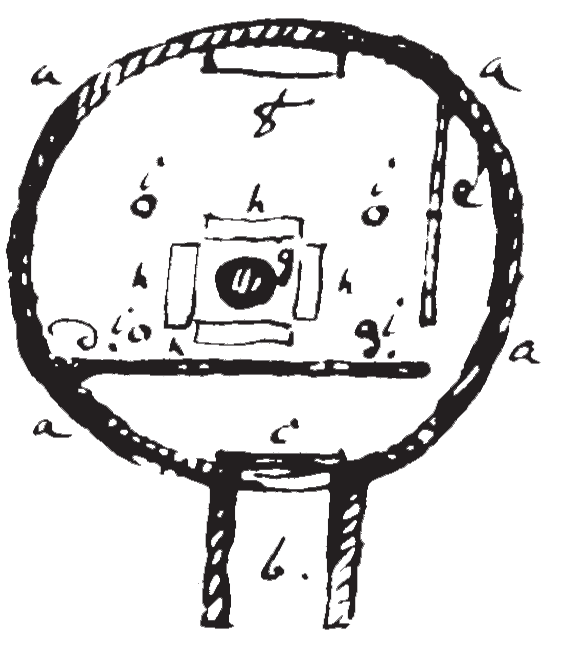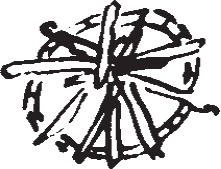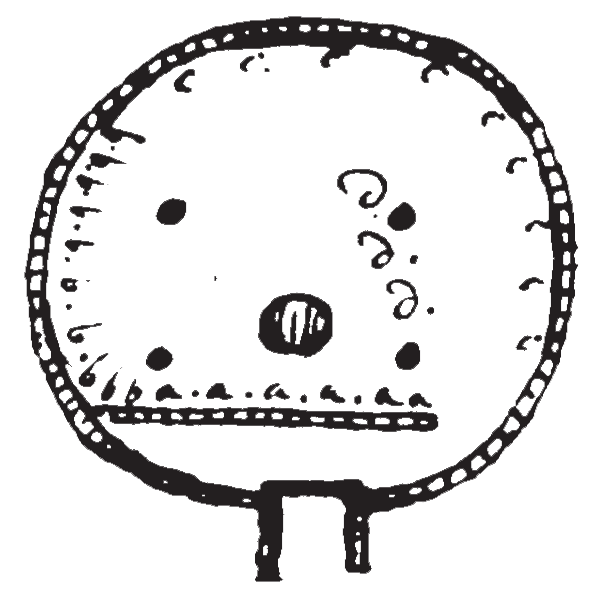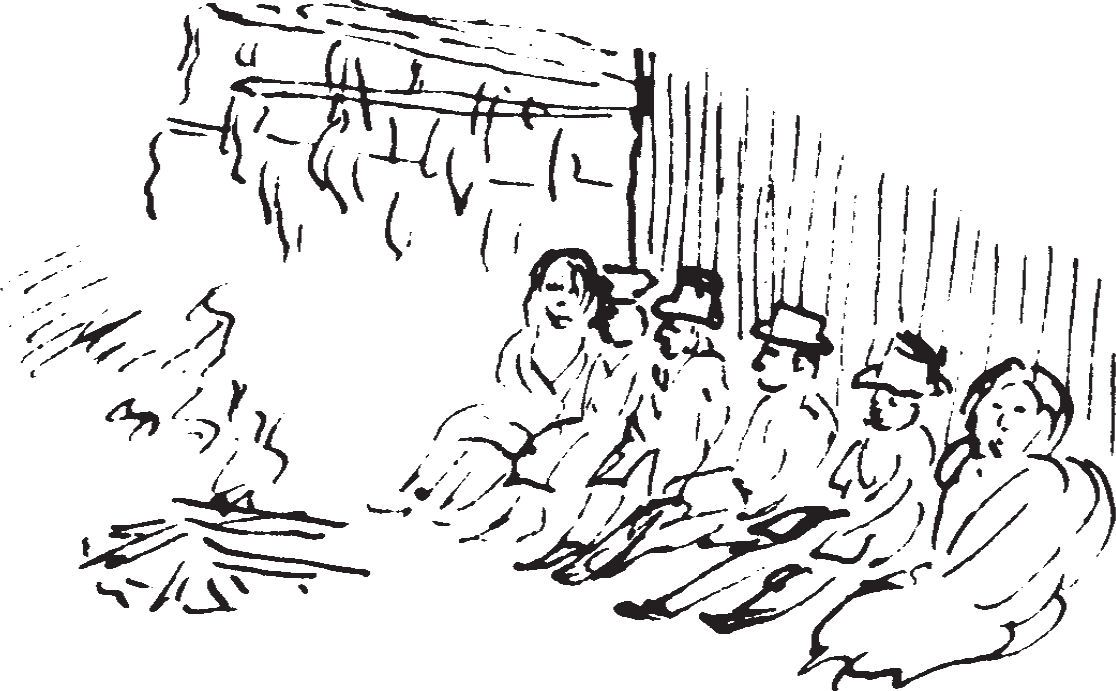December 3, 1833
3 December: In the morning, warm, cloudy sky, calm. At seven thirty, 21°F [−6.1°C]. Dreidoppel went out at dawn to lure a wolf. He shot but missed. After breakfast I went with him to the dead wolf, which was a few miles distant; [it was] still untouched but frozen solid. We saw another one; without doubt the one Dreidoppel had shot at today. It ran close up into the hills. We followed. Dreidoppel pursued it into a deep ditch and lured it, whereupon he hit it again at 80 paces. When I caught up, we found [that] the wolf, a female, had died. We carried it home and took the head of the other one along. Weather calm, very warm and pleasant. At twelve o’clock, 41°F [5°C]. We had hardly returned when we heard a dog howling pitifully. It was Mr. Kipp’s. An Indian [had] shot it in the hind leg with an arrow. The arrow penetrated deep; they pulled it out, but the iron tip remained stuck in the flesh. They searched but could not discover the culprit.
Mr. Kipp ordered an earlier dinner today, and we went at four thirty to the lower forest village of the Mandans to watch the Indian festivities, which last forty nights and are now exactly at their high point.M28Walk to the lower Mandan village to watch the ceremonies celebrating the sale of the Soldier (Káua-Karakáchka) [society] to the Crow society Les Chiens fous Manass OchkaBefore [the time] to leave, Mató-Tópe came and said [that] below their forest village in the prairie hills, a troop of hostile Indians (Dacotas) had been sighted. Everyone was tense. Mató-Tópe wanted to stay the night with us, but he returned with us to his village. Mr. Kipp loaded our woolen blankets on one of his horses, and his wife (a Mandan Indian) rode [that] horse. Síh-Sä and the young Indian were still with us. Mr. Kipp, Bodmer, Dreidoppel, Mató-Tópe, Síh-Sä, and the woman advanced quickly across the prairie along the Missouri. We turned when we arrived at the forest to the right below the prairie hills, which are rather high there. I cannot deny that the whole party looked left and right as we passed the various gorges and small creeks to ensure [that] no enemies were hiding there. We had to pass a place, a narrow gorge behind dense bushes, where many Indians had been killed by enemies. We followed the hills [for] a long stretch and turned to the left down into the forest; after a trip of a good hour, we reached the lodges of the Indians at dusk. These were closely packed in a dense forest. There were 70 lodges, and for each of them, one can count two men. There was already bustling everywhere in the village; one heard singing, whooping, and calling.

We went into the lodge of Medicine Bird (Mandeck-Suck-Choppeníh), Mr. Kipp’s father-in-law, where we spent the night. The lodge was well furnished; it was 20 paces in diameter. The outside wall, ‘a’, [is] supported on the inside by strong pillars. Above is a square smoke hole in the center of the ceiling. The walls lean inward [and are] covered with strong, cut timber kept in place by crossbars, made tight on the outside with reeds and brushwood, sod and soil. The entrance, ‘b’, [is] protected by two protruding walls [and] covered above like [an arch]; it is closed on the inside by a hanging door made from thick leather and parchment and kept in place by wooden stretchers. If one wants to enter the lodge, one pushes the door slightly aside. [Page 3:45]As soon as one enters the lodge (‘i’ = the four pillars of the lodge), one faces ‘dd’, a transverse partition made very tight with pieces of wood, reed, and brushwood. [This] is attached to the left side of the exterior wall, ‘a’, but leaves an entrance to the right to the inside of the house. Another partition is only half as high, i. e., a low wall. [This wall], ‘e’, closes off space for the horses, [kept] there only during the night. Just in front of the partition ‘dd’, ‘g’ represents the area where there is a small round or square [pit] for the fire. The [firepit] is set off with stones slanting [out to] the rim.

The firewood [can be] moderately thick [but is] mostly thin, slightly long pieces and is put on the rim in arc-like fashion toward the inside so that all [pieces] cross at the center and burn there. As they burn down, they are pushed in, always by removing the large pieces from below to be put on top. They say this is the way the Lord of Life instructed them to do. In a square around this [hearth], willow branches are fastened to the floor over which buffalo hides, the hair on top, are spread to sit on, [but] often the willow benches [are just] laid flat on the floor [and] are not covered.

The family sits around the fire the whole day, engaged in various occupations. Above the fireplace a chain with hooks [on which] to hang the cooking kettle [dangles] down from the crossbeams of the ceiling. The floor of the lodge is bare soil. In ‘f’ there was a bed made the way I described the Hidatsa [version] earlier, of leather with a square opening (see page 41 of this volume). In other lodges there are usually several. The host was absent, and we saw only the women and the son-in-law, who belongs to the Káua-Karakáchka, the band selling the dual war pipe today. We smoked, sitting around the fire, and they cooked for us a large wooden bowl of sweet corn, which tasted a little like green peas (petits poix).
Already several drums could be heard in the village, calling together the two societies of Káua-Karakáchka (soldats) and Meniss-Óchka Hähderucha-Óchatä (Les chiens fous Crows’ society). After seven o’clock Mr. Kipp gave the signal, and we went to the medicine lodge.  It had been emptied, and women sat around at the walls. We sat down at the place of honor, together with some respected Indians (all of them belonged to the Káua-Karakáchka band), in the center in front of the fire. We and a few [distinguished] soldats sat at ‘aa’. At ‘b’ sat the other men of this society; [they] count about 25 members. They were dressed in various ways, some better [but] most very simply, bare on their upper bodies, covered only with their robes. Some wore nice leggins and feather plumes on their heads, but only a few. In the center of their row sat three men who beat the drum very hard; among them was Old Bear (with his grayish white hair) and the son-in-law of Medicine Bird, our host today. At ‘ddd’ opposite the Káua-Karakáchka stood the men of the Meniss-Óchka Hä́hderucha-Óchatä band, which today bought from the former the double war whistle (Íschchä) [and] the dance belonging to it the dance of the Half-Shorn Heads [and also] all the apparatus and rights that go with it (see the [chapter on] the Mandan tribe). They have to ingratiate themselves to the former to gain permission for the purchase and have to give them many things of value: horses, woolen blankets, kettles, cloth, guns, and the like. They hold these festivities for forty nights, regale them with tobacco, give them food to eat, and give them their women, as we would soon see. The Káua-Karakáchka consented [to the transfer], and the festivities were carried out in the following manner: When we had taken a seat, the majority of the Káua-Karakáchka were not yet present. We suddenly heard their singing, accompanied by drumbeats, and they walked in with their insignia.M29Íschohä-Kakoschóchatä, the insignia of the Double war whistle Half-Shorn Heads. These consist of four lances, probably seven to eight feet long; the tip is of iron, similar to a rapier blade, and is carried with the iron tip downward. The [shaft] is tightly wound with broad strips of otter skin (as with the Blackfoot). From the tip and three other places, strips of skin hang [down] in pairs. Two of these [staffs] are bent on top; two are straight. The fifth insignia consisted of a red-painted head breaker [war club] of the usual [gunstock]
It had been emptied, and women sat around at the walls. We sat down at the place of honor, together with some respected Indians (all of them belonged to the Káua-Karakáchka band), in the center in front of the fire. We and a few [distinguished] soldats sat at ‘aa’. At ‘b’ sat the other men of this society; [they] count about 25 members. They were dressed in various ways, some better [but] most very simply, bare on their upper bodies, covered only with their robes. Some wore nice leggins and feather plumes on their heads, but only a few. In the center of their row sat three men who beat the drum very hard; among them was Old Bear (with his grayish white hair) and the son-in-law of Medicine Bird, our host today. At ‘ddd’ opposite the Káua-Karakáchka stood the men of the Meniss-Óchka Hä́hderucha-Óchatä band, which today bought from the former the double war whistle (Íschchä) [and] the dance belonging to it the dance of the Half-Shorn Heads [and also] all the apparatus and rights that go with it (see the [chapter on] the Mandan tribe). They have to ingratiate themselves to the former to gain permission for the purchase and have to give them many things of value: horses, woolen blankets, kettles, cloth, guns, and the like. They hold these festivities for forty nights, regale them with tobacco, give them food to eat, and give them their women, as we would soon see. The Káua-Karakáchka consented [to the transfer], and the festivities were carried out in the following manner: When we had taken a seat, the majority of the Káua-Karakáchka were not yet present. We suddenly heard their singing, accompanied by drumbeats, and they walked in with their insignia.M29Íschohä-Kakoschóchatä, the insignia of the Double war whistle Half-Shorn Heads. These consist of four lances, probably seven to eight feet long; the tip is of iron, similar to a rapier blade, and is carried with the iron tip downward. The [shaft] is tightly wound with broad strips of otter skin (as with the Blackfoot). From the tip and three other places, strips of skin hang [down] in pairs. Two of these [staffs] are bent on top; two are straight. The fifth insignia consisted of a red-painted head breaker [war club] of the usual [gunstock] shape with a flat iron tip at the end, decorated with some down and other feathers.[Page 3:46] Then [came] three lances, decorated with hanging feathers, alternating black and white. [The] ninth [insignia was] a very nicely decorated quiver and bow. The festivities began when the Káua-Karakáchka entered. They stopped at the entrance [to] the lodge, [and] we could not see them, because of the wall [screening] the door; their insignia, however, they held into the lodge, [including] the head breaker [war club]. When they had stood, sung, and drummed for a while in this position,
shape with a flat iron tip at the end, decorated with some down and other feathers.[Page 3:46] Then [came] three lances, decorated with hanging feathers, alternating black and white. [The] ninth [insignia was] a very nicely decorated quiver and bow. The festivities began when the Káua-Karakáchka entered. They stopped at the entrance [to] the lodge, [and] we could not see them, because of the wall [screening] the door; their insignia, however, they held into the lodge, [including] the head breaker [war club]. When they had stood, sung, and drummed for a while in this position,  they stepped forward, leaned the four lances against the wall [and] stuck the war club in the ground near a pillar. All of these men took their seats, as indicated above [see previous page], and the drumming commenced.
they stepped forward, leaned the four lances against the wall [and] stuck the war club in the ground near a pillar. All of these men took their seats, as indicated above [see previous page], and the drumming commenced.
[From 3:45] Soon the drums were beaten violently, forcefully struck with heavy mallets. They alternately sang and whooped [a] war whoop, made by striking their mouth with the hand to produce a trembling sound. This music was repeated over and over again with short pauses in between. Usually they start to beat the drums quietly and fast, almost like a roll. Then they produce less fast but very strong beats, and the singing matches the drum. While this music [3:46] continued in intervals [strikeout illegible], the purchasing society offered their pipes. They offered them to all of us by bowing down and holding the mouthpieces toward us. Then they took a few puffs themselves and went to the next person on the left, but only to the strangers and to the Káua-Karakáchka. Thus we continued to smoke, and to each one of us was also distributed a small cake of fat kneaded with sweet corn. After this had lasted about half an hour, two of the soldats got up and danced toward each other. One of them was a heavy, tall, thickset man with a small, fine voice (he seemed to have chest complaints). [He had] a naked upper body and leggins without any decoration.
He grabbed the war club and held it firmly in his left hand, [while] his right hand hung down stiffly. He bent his upper body forward and jumped up and down to the rhythm of the music, keeping his feet almost even. The other one was beautifully adorned on his head and legs; his upper body was naked, too. He grabbed one of the otter-skin lances see note (1.) and held it slanted above him with both hands. They danced toward each other as described above. After one or two minutes, the latter put the lance aside and sat down. The warriors did their whooping and war cries; the drums were beaten violently and then fell silent. The tall man with the war club then addressed the purchasing band, called them his sons and related some of his war coups. Then he offered them the war club. One of the Meniss-Óchka Hä́hderucha-Óchatä accepted the weapons called the presenter his father, stroked him with his hand downward over his arm, took the weapon out of his hand, and put it again in its place. The other dancer stood up again, did the same, talked about his coups, and presented the lance again to a member of the other band, who accepted it with the same ceremony and returned it to its place. Then they sang and played the big drum, but no chichikué was to be heard. They [alternately?] smoked, sang, and played the big drum. Then a few other soldats stood up and spoke of their heroic deeds, how they had stolen horses or taken a medicine from an enemy, and handed over [a] war club and lance to the purchasing band.
When this had happened about four to six five times, the women rose. Four of them appeared, one after the other, completely naked, quickly grabbed the four lances, and [in succession] carried them outside and then back inside. They hurried to pass us, and some held their hands in front. This ceremony was repeated twice. These naked women came and approached, one after the other in intervals—first the guests, then the soldats—and invited them to follow. This [invitation was extended by] stroking the whole length of [a man’s] arms with their hands. [The women] turned around and went outside, whereupon one had to follow them. The man was led by a woman in front of the lodge, where she wrapped her robe around herself. Then he was led to a lonely spot where he paid tribute to her charms. When they came in for the second time with their lances, Mr. Kipp rose; none of us waited for the second invitation—which we had done at the Hidatsas under similar circumstances at the buffalo medicine festival, which was also being celebrated here in another lodge (four successive nights) today. Of the naked women, some were thick and fat, [while] a few [were] still very young, one almost a child. We returned to the lodge of Medicine Bird, smoked a cigar in his absence, and lay down in our clothes on the spread-out buffalo skins. We had our blankets with us. The night was rather chilly. It froze and there was hoarfrost. The Indians had posted sentries against their enemies.


